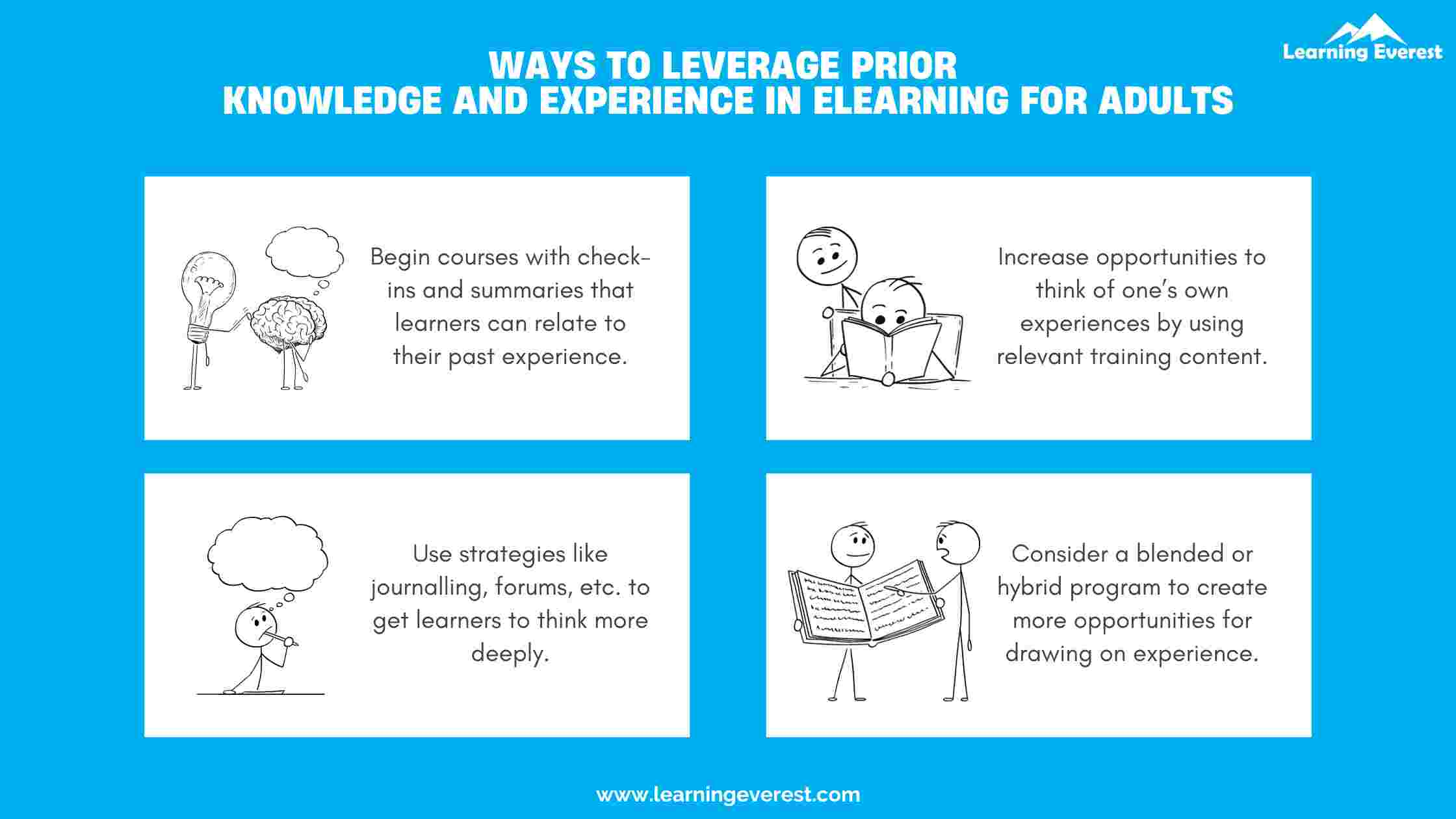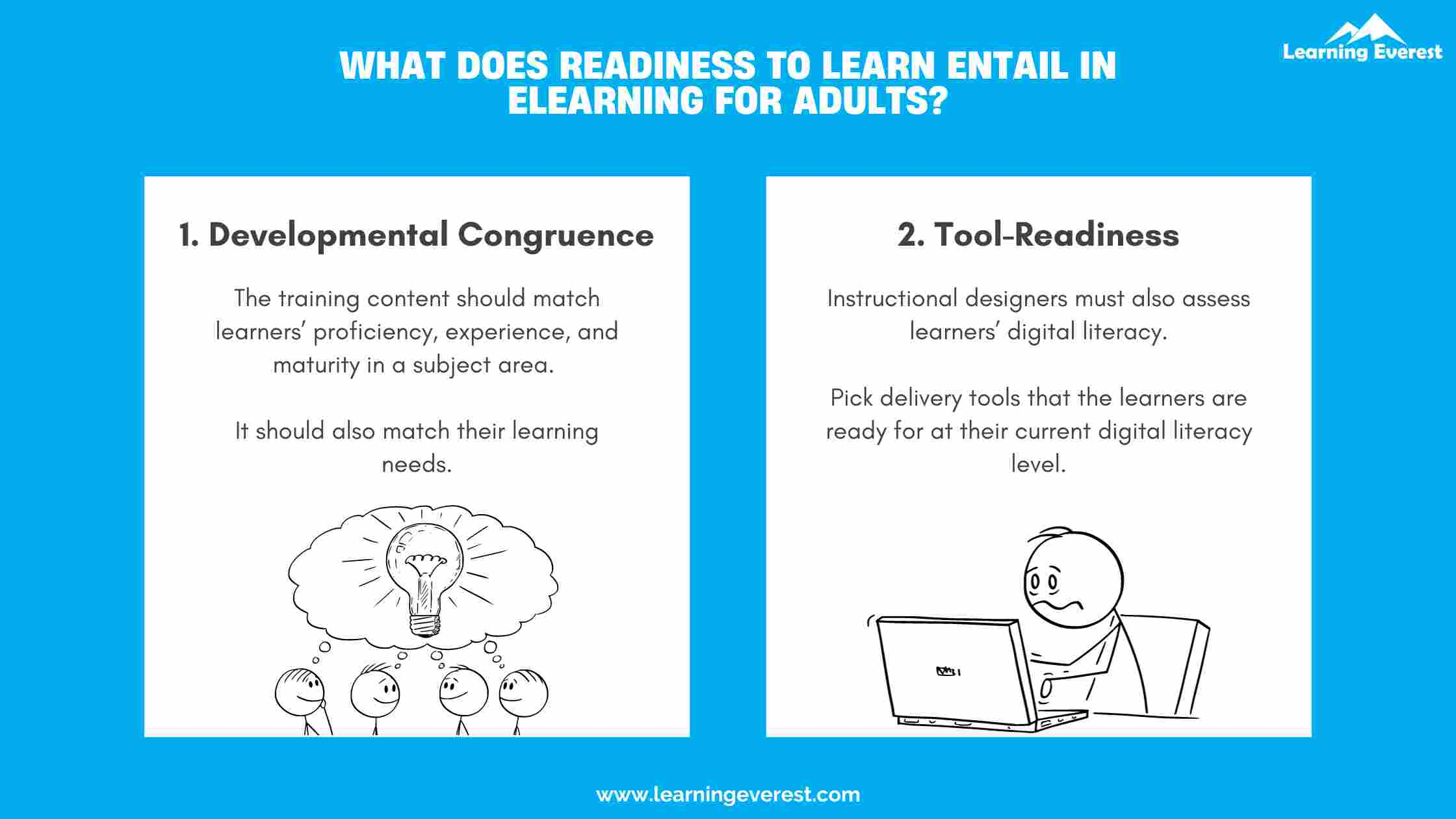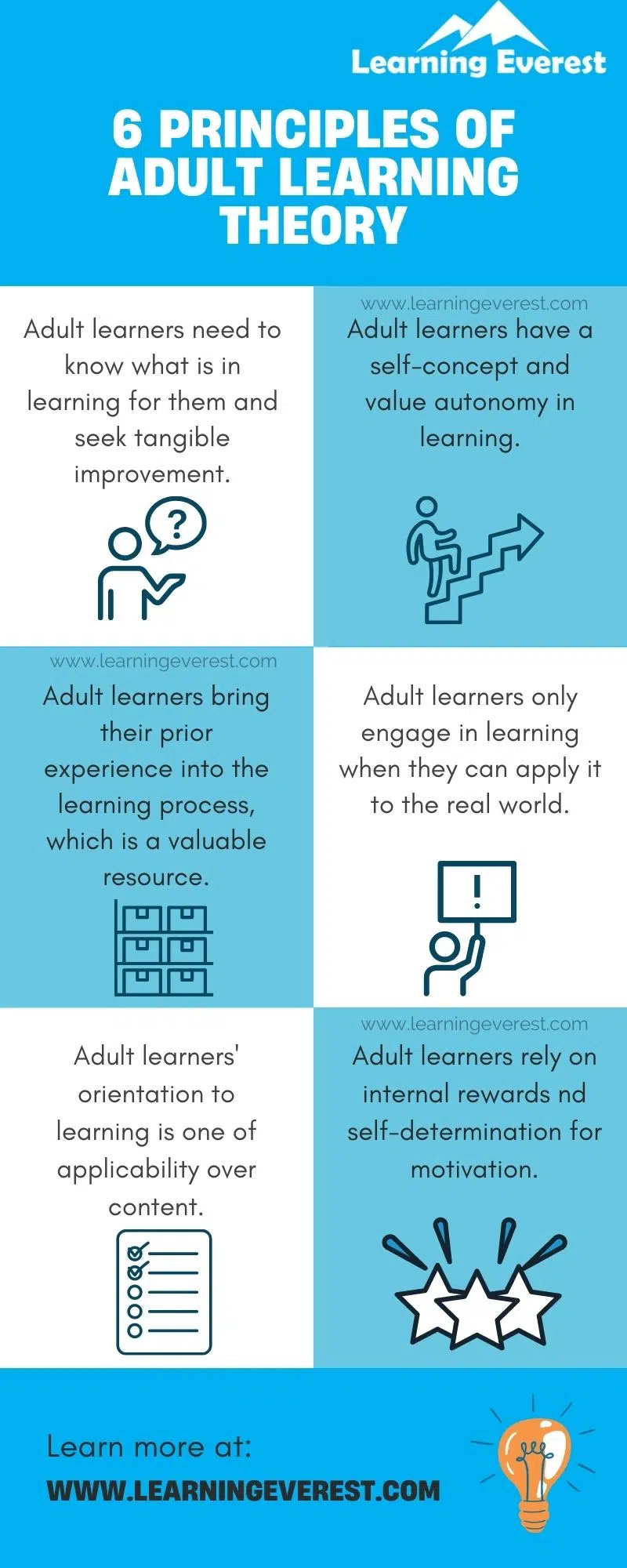The adult learning theory, also known as andragogy, discusses how adults differ from children in their learning approach and requirements.
First introduced in the 1960s by Malcolm Knowles, the theory has shaped adult learning activities for decades. This theory’s strengths are its simplicity and empathy for adults’ learning, as well as growth and esteem needs.
Applying andragogy to e-learning is an effective design methodology. However, it also produces some unique challenges to be mindful of.
What is Adult Learning Theory?
Adult learning theory is a set of principles and assumptions about how adults learn. While the theory was coined in the 1960s, Malcolm continued to develop it well into the 90s. At present, the andragogy model has six principles that outline adult learners’ characteristics, needs, and motivations.
The six principles are as follows:
- A Learner’s Need to Know: Adult learners cannot receive instruction blindly. They need to know what is in it for them, how it will benefit them, and why they require it in the first place. Thus, the most efficient way to engage and motivate a learner is to promise a tangible improvement.
- The Learner’s Self-Concept: Unlike children, adults are autonomous and self-directed. They need to feel in control of their personal development. In a learning context, autonomy and self-direction translate to independence and the ability to make choices that impact the learning process. Feeling stifled and personally undermined will negatively affect the individual’s learning outcomes.
- The Learner’s Personal Experience: Each adult learner has unique experiences, knowledge, and skills. This personal trove forms the foundation on which they build new learning. Thus, prior experiences are valuable resources and should be used as such.
- The Learner’s Readiness to Learn: A learner’s readiness to learn is determined by whether they can apply their learnings to the real world. In other words, whether it is developmentally congruent to where they are in life. Learners use this benchmark to decide whether to enroll or participate in a course or program. However, instructional designers also need to take this principle into consideration.
- The Learner’s Orientation to Learning: Orientation to learning refers to the purpose and direction individuals want their learning to have. Adult learners prioritize applicability over content. They want their learning to be life, problem, and context-centered. Thus, learning must be actionable in everyday life.
- The Learner’s Motivation to Learn: While children usually derive motivation from external rewards, adult learners rely on internal rewards. This stems from their desire to exercise free will and self-determination. Internal rewards occur when a learner’s internal motivational needs are met.
E-Learning Challenges in Adult Learning Theory
As you can probably tell, adult learning theory has some recurrent themes that can be summarized into three key points:
- An adult learner’s self-concept and individuality are paramount to the learning process. The principles of personal experience, readiness to learn, and motivation to learn all reflect this. External factors hold little value, but individual development remains a consistent topic.
- Adult learners want to learn to do.
- Adult learners always have clear reasons for learning.
While e-learning’s benefits are many, such an individual-centred approach can still be tricky territory for those with lesser experience. Applying adult learning theory to a live, offline session or program is comparatively simpler than incorporating these highly personalized principles into an e-learning framework. This still stands whether the program is instructor-led or not.
1. Prior Experience – A Double-Edged Sword
In adult learning theory, learners’ experiences are an invaluable resource. Individual differences in experiences are a tool to broaden and enrich learners’ worldviews. At the same time, they are instruments to facilitate creative problem-solving and engagement. By hearing, observing, and interacting with each other, learners can reach insights of their own.
However, Knowles also believed that experiences shape biases. Biases are inherently counter-productive to learning, and adult instruction needs to handle them delicately. Some biases need to be explored and challenged, while others can co-exist with new learning. However, a learner’s sense of self and the validity of their experiences cannot be undermined.
In a virtual instructor-led program, complex discussions like this are easy to execute. However, asynchronous learning structured for brevity might not cater to such deep dives. Additionally, asynchronous learning might fail to offer any kind of interaction altogether.
Thus, subject matter experts and instructional designers need to carefully ensure that learners have cues to build on past experiences.
The following tips can make a course more reflective and leverage prior experiences:
- Start lessons with check-ins or summaries of the main topic, followed by a cue to relate it to one’s personal experiences
- Provide case studies, stories, news articles, research papers, etc. to increase opportunities to think about one’s own experiences
- Use strategies like journaling, blogposts, course-specific forums, and written exercises to get the learners to think
- Build blended and hybrid learning programs, when feasible

Ways to Leverage Prior Knowledge and Experience in eLearning for Adults
2. Readiness to Learn – Technological Development
E-learning adds a new layer to a learner’s readiness to learn. Virtual learning content needs to check two boxes:
- Whether it is developmentally congruent to the learner’s maturity and learning needs
- Whether it fits the learner’s level of digital literacy
Thus, instructional designers also need to consider factors such as delivery platforms and interface.
For instance, learners might be ready to learn a program’s curriculum but feel uncomfortable navigating it virtually.
Thus, along with assessing the target audiences’ knowledge levels and requirements before, IDs must examine whether they have tool-readiness.
Any well-established instructional design model, such as ADDIE or Kirkpatrick, can incorporate a tools readiness assessment.
Along with assessing tool readiness, instructional designers can consider the following:
- Designing clean interfaces
- Providing tutorial videos before courses
- A step-by-step introductory orientation for the tool(s) being used
- A helpdesk or FAQ page
- Labels for icons, buttons, and menus

What Does Readiness to Learn Entail in Adult eLearning
3. Motivation and Orientation to Learning – Appealing to the Learner’s Intrinsic Reward System
An e-learning course that effectively employs adult learning theory is one that caters to learners’ personal needs and intrinsic reward system. Learners only feel motivated to learn when they can see themselves using the knowledge they acquire. Thankfully, there are many resources to achieve this. The two most well-documented ones are:
- Bloom’s Taxonomy – a hierarchical taxonomy for writing learning objectives based on the cognitive complexity of the tasks. This taxonomy progresses from simple to complex and covers all stages of learning. It spans from understanding familiarity with concepts to practical application to create new designs, theories, and frameworks.
- Problem-based Learning – this is a prevalent instructional technique. In problem-based learning, learners are given problems, often divided further into smaller components. Along with the problem, they receive supplementary resources which they need to use on their own to solve the problem. The instructor provides very little guidance at this stage, and the goal is to get learners to organize information on their own. This way of learning is personally rewarding and helps learners figure out how to apply concepts in real-world scenarios. To enhance problem-based learning even further, learners can be divided into groups.
Additionally, using a good Learning Management System can give learners a consolidated tracking system and convenient access to learning material for just-in-time situations.
Closing Remarks
Although e-learning has been around for a while now, it is still finding its theoretical footing. Due to being an unprecedented blend of learning and technology, e-learning is a field where innovation thrives. Thus, the efficacy of adult learning theory even in e-learning has mounted evidence for itself.
Knowledge Check!
Infographics
Frequently Asked Questions (FAQs)
What is adult learning theory?
Adult learning theory is a set of principles and assumptions about how adults learn. While the theory was coined in the 1960s, Malcolm continued to develop it well into the 90s. At present, the andragogy model has six principles that outline adult learners’ characteristics, needs, and motivations.
What are the six principles of adult learning theory?
The 6 principles of adult learning theory are:
- Learners need to know
- Learners have a self-concept
- Learners have prior experience they bring to the course
- Learners show readiness to learn
- Learners have a problem and context-centered orientation to learning
- Learners are intrinsically motivated to learn
How do adults use theory in teaching?
The theory used to teach adults is called andragogy or adult learning theory. Adult learning theory has some recurrent themes that can be summarized into three key points:
- An adult learner’s self-concept and individuality are paramount to the learning process. The principles of personal experience, readiness to learn, and motivation to learn all reflect this. External factors hold little value, but individual development remains a consistent topic.
- Adult learners want to learn to do.
- Adult learners always have clear reasons for learning.






